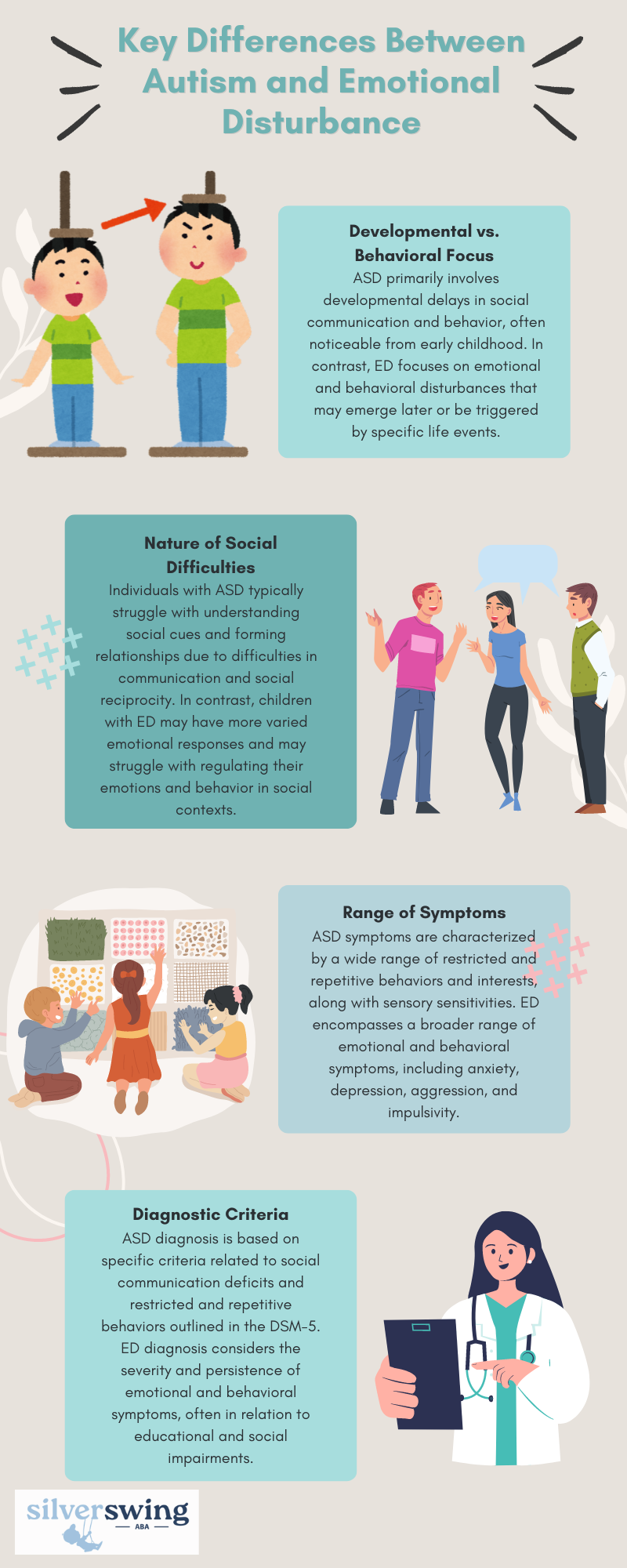Autism spectrum disorder (ASD) and emotional disturbance (ED) are two distinct but sometimes overlapping conditions that affect individuals differently in their social, emotional, and behavioral development.
This article aims to clarify the differences between these two conditions, explore their unique characteristics, and highlight important considerations in diagnosis and intervention.

Overview of Autism Spectrum Disorder
Autism spectrum disorder is a neurodevelopmental condition characterized by challenges in social interaction, communication, and restricted or repetitive behaviors. The term “spectrum” reflects the wide variation in symptoms and severity among individuals with ASD. It typically manifests early in childhood, often before the age of three, and persists throughout life.
Its core features are as follows:
- Social Communication Challenges – Individuals with ASD may have difficulty understanding and using verbal and nonverbal communication cues such as facial expressions, gestures, and tone of voice. They may struggle with initiating and maintaining conversations, understanding sarcasm or jokes, and may prefer solitary activities.
- Restricted and Repetitive Behaviors – This includes repetitive movements (e.g., hand-flapping, rocking), insistence on sameness or routines, intense interests in specific topics, and sensory sensitivities (e.g., to light, sound, textures).
- Sensory Sensitivities – Due to how autism affects thinking, many individuals with ASD experience heightened sensitivity or under-sensitivity to sensory stimuli, which can impact their daily functioning and behavior.

Diagnosis of Autism Spectrum Disorder
Diagnosing ASD involves comprehensive assessment by healthcare professionals, including developmental pediatricians, psychologists, or psychiatrists.
The diagnostic criteria are outlined in the Diagnostic and Statistical Manual of Mental Disorders (DSM-5), which includes impairments in social communication and the presence of restricted and repetitive behaviors.
The exact causes of ASD are complex and multifactorial, involving genetic, environmental, and possibly immunological factors. Recent studies have identified genetic mutations and variations that increase the risk of ASD, but no single gene or environmental factor explains all cases.

Overview of Emotional Disturbance
On the other hand, emotional disturbance is a broader category that encompasses a range of emotional and behavioral disorders in children and adolescents. It is defined under the Individuals with Disabilities Education Act (IDEA) and includes conditions such as anxiety disorders, mood disorders (e.g., depression), bipolar disorder, conduct disorders, and schizophrenia.
Unlike ASD, ED is not solely characterized by developmental delays but by significant challenges in emotional regulation and behavior.
Here are its characteristics:
- Emotional Regulation Difficulties – Children with ED may exhibit excessive fears, anxieties, or depression that interfere with their daily functioning. They may have difficulty controlling their emotions, leading to frequent outbursts or withdrawal.
- Behavioral Challenges – This includes disruptive behaviors such as aggression, defiance of rules, impulsivity, and difficulty forming and maintaining relationships with peers and adults.
- Academic and Social Implications – ED can significantly impact academic performance and social integration, as children may struggle with attendance, peer interactions, and completing schoolwork.

Diagnosis of Emotional Disturbance
Diagnosing ED involves a comprehensive evaluation by mental health professionals, educators, and sometimes medical specialists. The criteria focus on the severity and persistence of emotional and behavioral symptoms, their impact on academic and social functioning, and the presence of underlying psychological disorders.
The causes of ED are also multifaceted and can include genetic predispositions, environmental stressors (e.g., trauma, family dynamics), neurobiological factors, and disruptions in early childhood development.
Effective treatment often involves a combination of therapeutic interventions, medication management (if indicated), and support from educators and caregivers.
Key Differences Between Autism and Emotional Disturbance
While both ASD and ED involve challenges in social and emotional functioning, there are several key differences that distinguish these conditions. These are as follows:

That said, there can also be overlap between ASD and ED, as some individuals may exhibit both developmental and emotional-behavioral difficulties. This overlap can complicate diagnosis and treatment planning, requiring careful consideration of individual strengths, challenges, and environmental factors.
Interventions and Support Strategies
Effective interventions for ASD and ED focus on addressing individual needs and enhancing overall functioning. These can be done through the following:
- Behavioral and Educational Interventions – Applied Behavior Analysis (ABA), social skills training, cognitive-behavioral therapy (CBT), and individualized education plans (IEPs) are commonly used for children with ASD and ED to improve social, communication, and behavioral skills.
- Family and Community Support – Providing support and education to families, caregivers, and educators is crucial for creating a supportive environment that promotes learning and social integration.
- Medication and Therapeutic Support – In cases where emotional disturbances co-occur with ASD, medication management and therapeutic interventions tailored to specific symptoms (e.g., anxiety, depression) may be recommended.
Understanding the distinctions between autism spectrum disorder (ASD) and emotional disturbance (ED) is essential for accurate diagnosis, intervention planning, and support provision.
While ASD primarily involves developmental challenges in social communication and behavior, ED encompasses a broader range of emotional and behavioral disturbances. Recognizing the unique features of each condition facilitates early intervention and improves outcomes for individuals affected by these complex neurodevelopmental and emotional-behavioral disorders.
Ongoing research and clinical advancements continue to refine our understanding and approaches to supporting individuals with ASD, ED, and overlapping presentations.




